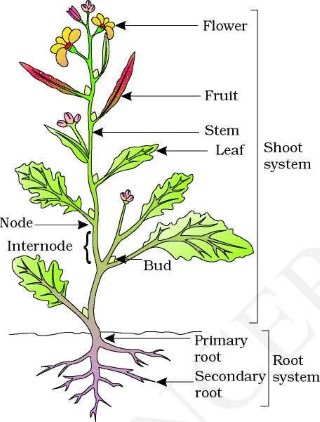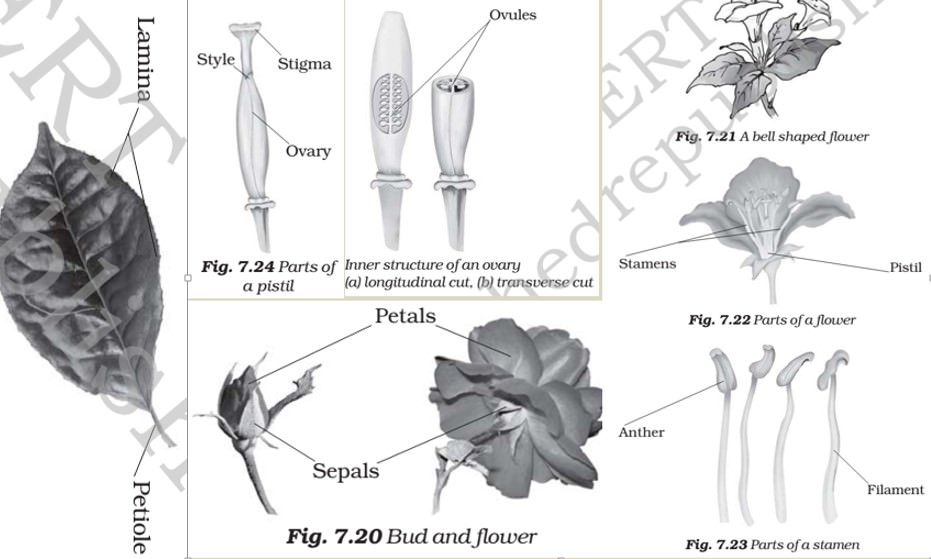Plant Parts and Their Functions – Structural Organization in Plants
The Root
- The main functions of the root system are absorption of water and minerals from the soil, providing a proper anchorage to the plant parts, storing reserve food material and synthesis of plant growth regulators.
- In majority of the dicotyledonous plants, the direct elongation of the radicle leads to the formation of primary root which grows inside the soil. It bears lateral roots of several orders that are referred to as secondary, tertiary, etc. roots. The primary roots and its branches constitute the tap root system, as seen in the mustard plant.
- In monocotyledonous plants, the primary root is short lived and is replaced by a large number of roots. These roots originate from the base of the stem and constitute the fibrous root system, as seen in the wheat plant.
- In some plants, like grass, Monstera and the banyan tree, roots arise from parts of the plant other than the radicle and are called adventitious roots.
Pic Credits: Biosci.ohio-state.edu
- The root is covered at the apex by a thimble-like structure called the root cap. It protects the tender apex of the root as it makes its way through the soil.
- Tap roots of carrot, turnip and adventitious roots of sweet potato, get swollen and store food.
- Hanging structures that support a banyan tree are called prop roots. Similarly, the stems of maize and sugarcane have supporting roots coming out of the lower nodes of the stem. These are called stilt roots.
- In some plants such as Rhizophora growing in swampy areas, many roots come out of the ground and grow vertically upwards. Such roots, called pneumatophores, help to get oxygen for respiration.
The Stem
- The region of the stem where leaves are born are called nodes while internodes are the portions between two nodes.
- Some stems perform the function of storage of food, support, protection and of vegetative propagation.
- Underground stems of potato, ginger, turmeric, zaminkand, colocasia are modified to store food in them.
- Stem tendrils which develop from axillary buds, are slender and spirally coiled and help plants to climb such as in gourds (cucumber, pumpkins, watermelon) and grapevines.
- Axillary buds of stems may also get modified into woody, straight and pointed thorns. Thorns are found in many plants such as Citrus, Bougainvillea. They protect plants from browsing animals.
- Some plants of arid regions modify their stems into flattened (Opuntia), or fleshy cylindrical (Euphorbia) structures. They contain chlorophyll and carry out photosynthesis.
- Underground stems of some plants such as grass and strawberry, etc., spread to new niches and when older parts die new plants are formed.
The Leaf
- Leaves originate from shoot apical meristems. Leaf develops at the node and bears a bud in its axil. The axillary bud later develops into a branch.
- A typical leaf consists of three main parts: leaf base, petiole and lamina.
- The petiole help hold the blade to light. Long thin flexible petioles allow leaf blades to flutter in wind, thereby cooling the leaf and bringing fresh air to leaf surface.
- The lamina or the leaf blade is the green expanded part of the leaf with veins and veinlets. There is, usually, a middle prominent vein, which is known as the midrib. Veins provide rigidity to the leaf blade and act as channels of transport for water, minerals and food materials.
Leaf Venation
- The arrangement of veins and the veinlets in the lamina of leaf is termed as venation.
- When the veinlets form a network, the venation is termed as reticulate. When the veins run parallel to each other within a lamina, the venation is termed as parallel.
- Leaves of dicotyledonous plants generally possess reticulate venation, while parallel venation is the characteristic of most monocotyledons.
Modifications of Leaves
- Leaves are often modified to perform functions other than photosynthesis. They are converted into tendrils for climbing as in peas or into spines [thorns] for defense as in cacti. The fleshy leaves of onion and garlic store food.
- Leaves of certain insectivorous plants such as pitcher plant, venus-fly trap are also modified leaves.
Root Modification | Stem Modification | Leaf Modification |
| Carrot and Sweet Potato. | Potato, Ginger, Turmeric, Zaminkand and Colocasia. | Onion and Garlic. |
Transpiration
- Plants absorb mineral nutrients and water from the soil. Not all the water absorbed is utilised by the plant. The water evaporates through the stomata present on the surface of the leaves by the process of transpiration.
- The evaporation of water from leaves generates a suction pull (the same that you produce when you suck water through a straw) which can pull water to great heights in the tall trees. Transpiration also cools the plant.
Water absorption through roots can be increased by keeping the plants
- in the shade
- in dim light
- under the fan
- covered with a polythene bag
- When we place a plant under the fan the speed of air flow is very high. Transpiration will take place in presence of high air flow through the stomata. Rate of transpiration increases during windy condition.
- Increase in the rate of transpiration increases the water absorption also because when transpiration occurs, it will create a transpiration pull and more water absorption will take place.
Do Plants Also Respire?
- In plants each part can independently take in oxygen from the air and give out carbon dioxide. Even roots can respire. Can you guess what would happen if a potted plant is overwatered?
- Plants carry out photosynthesis only during the day and respiration both during the day time as well as night.
- Did you know? For us oxygen is essential, but for those organisms which do not use it, oxygen is toxic. In fact, our white blood cells use oxygen to kill invading bacteria. Even for humans, it may be dangerous to breathe pure oxygen for long.
The Flower
- The flower is the reproductive unit in the angiosperms. It is meant for sexual reproduction. Androecium and gynoecium are reproductive organs.
- When a flower has both androecium and gynoecium, it is bisexual. A flower having either only stamens or only carpels is unisexual.
- Aestivation: The mode of arrangement of sepals or petals in floral bud with respect to the other members of the same whorl is known as aestivation.
Parts of a flower
Androecium
- Androecium is composed of stamens. Each stamen which represents the male reproductive organ consists of a stalk or a filament and an anther. Each anther is usually bilobed and each lobe has two chambers, the pollen-sacs. The pollen grains are produced in pollen-sacs. A sterile stamen is called staminode.
Gynoecium
- Gynoecium is the female reproductive part of the flower and is made up of one or more carpels. A carpel consists of three parts namely stigma, style and ovary.
- After fertilization, the ovules develop into seeds and the ovary matures into a fruit.
- Placentation: The arrangement of ovules within the ovary is known as placentation.
The Fruit
- The fruit is a characteristic feature of the flowering plants.
- It is a mature or ripened ovary, developed after fertilisation.
- If a fruit is formed without fertilisation of the ovary, it is called a parthenocarpic fruit.
- The Seed: The ovules after fertilisation, develop into seeds.
Transport Of Water And Minerals In Plants
- Plants absorb water and minerals by the roots. The roots have root hair. The root hair increase the surface area of the root for the absorption of water and mineral nutrients dissolved in water. The root hair is in contact with the water present between the soil particles.
- Can you guess how water moves from the root to the leaves? What kind of transport system is present in plants?
- Plants have pipe-like vessels to transport water and nutrients from the soil. The vessels are made of special cells, forming the vascular tissue.
- The vascular tissue for the transport of water and nutrients in the plant is called the xylem. The xylem forms a continuous network of channels that connects roots to the leaves through the stem and branches and thus transports water to the entire plant leaves synthesise food.
- The food has to be transported to all parts of the plant. This is done by the vascular tissue called the phloem. Thus, xylem and phloem transport substances in plants.
Summary
- Flowering plants exhibit enormous variation in shape, size, structure, mode of nutrition, life span, habit and habitat. They have well developed root and shoot systems.
- Root system is either tap root or fibrous. Generally, dicotyledonous plants have tap roots while monocotyledonous plants have fibrous roots.
- The roots in some plants get modified for storage of food, mechanical support and respiration. The shoot system is differentiated into stem, leaves, flowers and fruits.
- The morphological features of stems like the presence of nodes and internodes, multicellular hair and positively phototropic nature help to differentiate the stems from roots. Stems also get modified to perform diverse functions such as storage of food, vegetative propagation and protection under different conditions.
- Leaf is a lateral outgrowth of stem developed exogeneously at the node. These are green in colour to perform the function of photosynthesis. Leaves exhibit marked variations in their shape, size, margin, apex and extent of incisions of leaf blade (lamina). Like other parts of plants, the leaves also get modified into other structures such as tendrils, spines for climbing and protection respectively.
- The flower is a modified shoot, meant for sexual reproduction. The flowers are arranged in different types of inflorescences. They exhibit enormous variation in structure, symmetry, position of ovary in relation to other parts, arrangement of petals, sepals, ovules etc.
- After fertilisation, the ovary is converted into fruits and ovules into seeds. Seeds either may be monocotyledonous or dicotyledonous. They vary in shape, size and period of viability. The floral characteristics form the basis of classification and identification of flowering plants. This can be illustrated through semi-technical descriptions of families. Hence, a flowering plant is described in a definite sequence by using scientific terms. The floral features are represented in the summarised form as floral diagrams and floral formula.
- Water comes out of leaves in the form of vapour by a process called transpiration. Plants release a lot of water into the air through this process.







0 Comments